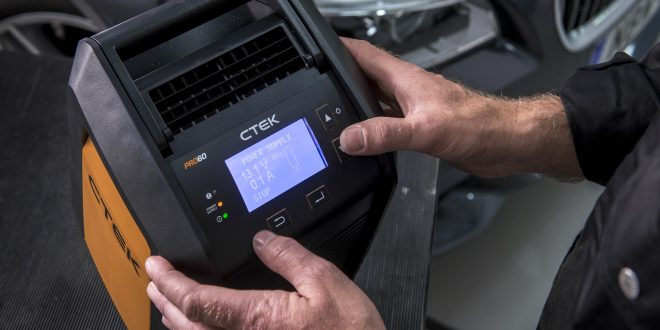When a vehicle arrives in the workshop for any type of fault-finding or repair, the first thing you will do in most cases is connect it to a diagnostics machine to find out where the fault is. But, if the battery is not supported throughout the process and already has low voltage, an incorrect error code may be reported through the diagnostics – known as a ‘ghost fault’. Ghost faults can happen because the vehicle is trying to protect the unsupported battery, which it does in many cases by shutting down the systems it does not really need, like the sound system, the air conditioning, or the start/stop function – and these can then be recorded as a fault.
So, when we talk about ghost faults, we mean a fault that your diagnostic tool detects for one component, that has actually arisen from another – any clearer?! If you do not know the underlying cause of the original fault, you may end up trying to repair a fault that is not really there, thereby the name ‘ghost fault’.
CTEK has some tips on how to avoid ghost faults in your workshop.
Before undertaking diagnostic work it is important to check the condition of the battery to see if the voltage is low. When the vehicle is undergoing diagnostics or service, it is crucial that the battery is hooked up to a battery support unit.
By making sure that a vehicle battery is tested when it first enters the workshop, and supported during any diagnostic procedures, workshops will avoid frustrating and misleading “ghost-faults” that can cost essential time and money.
If you do not realise that the battery has a problem with low voltage, you will be looking for a fault that is not there. Ghost faults can increase service times, risking the efficiency of the workshop and their reputation.
CTEK recommends two crucial steps when the vehicle arrives at the workshop:
- Firstly, you need to test the battery to identify if the battery has low voltage. For this, you could use CTEK’s PRO Battery Tester.
- Secondly, you need to connect the vehicle to a battery support unit, in supply mode, before you start doing any diagnostic work. Many battery support units, such as the CTEK MXTS40, PRO60 and PRO120, enable you to specify the required voltage, so that potential ghost faults do not appear.
Your diagnostic equipment will not work properly without the correct voltage supplied by a power supply unit. A stable and sufficient power supply can help prevent voltage fluctuations or drops that may trigger false or ghost error codes. Insufficient or unstable voltage can affect the accuracy and reliability of diagnostic readings, leading to incorrect results or incomplete diagnoses.
Mark Poole, Sales Manager for CTEK, said: “We know that around 50% of vehicles entering the workshop have a battery that needs attention – so it’s quite likely the battery will need support throughout any workshop procedure. Using a smart battery charger and support unit means that as well as supporting the battery it will charge it along the way too – protecting against the battery voltage dropping to even lower levels than when it arrived in the workshop.
“So, testing and supporting the battery during vehicle diagnostic and service work will give you the confidence that you won’t get spooky ghost fault reports, that can waste time, resources and give you a headache you could definitely do without!”
CTEK’s PRO products are ideal for use in the professional workshop. They have a stable voltage, selectable voltage and protects against de-rating. The battery support units are compatible with all types of 12V batteries and have automatic parallel load compensation.
For more information about the CS PRO range please visit www.ctek.com
